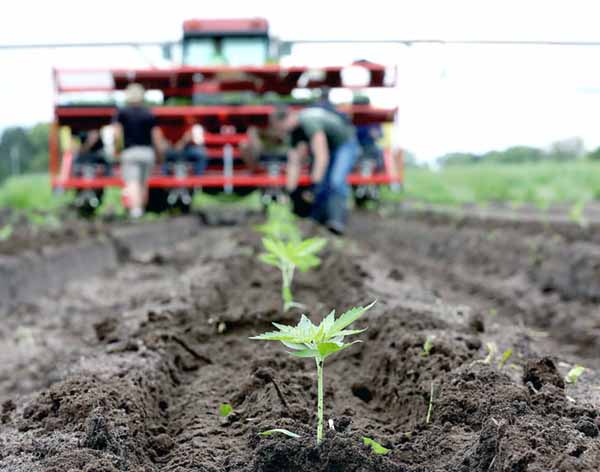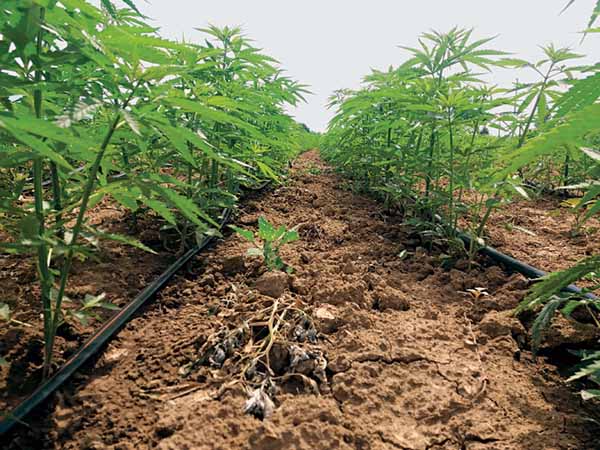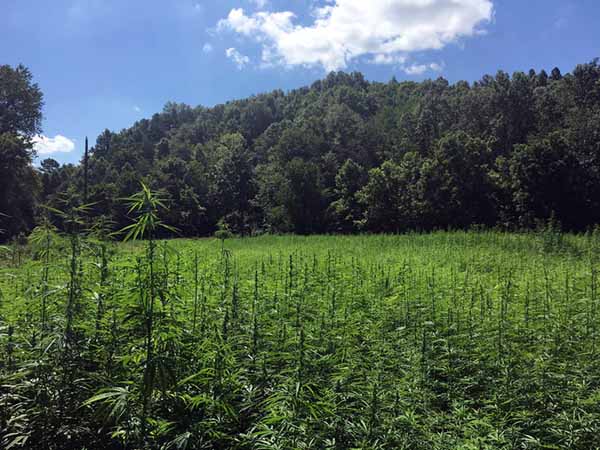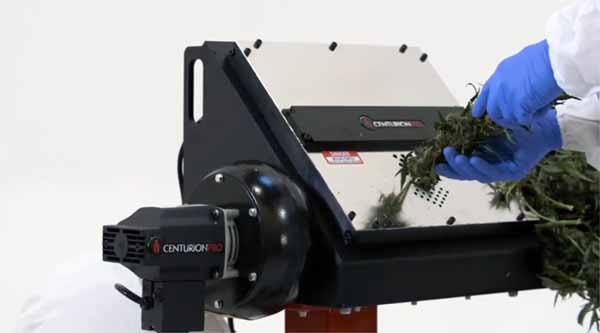Hemp stems consist of an outer ring of long bast fibres, in addition to an inner core of short stiff hemp hurds. Bast fibres are double the price of hemp hurds, with the longest and finest fibres fetching the highest price. Hemp fibre is one of the world’s most robust natural products, with extensive use in textiles, construction and agriculture. Its usage has been revived by hemp’s declassification around with world, with innovations that increase its applications forecast to drive the hemp fibre market to $260 million by 2024.
Hemp Harvesting
Hemp Fibre
 Dioecious hemp strains, with male and female organisms on separate plants, are considered the best for fibre production. To increase fibre quality, varieties are rigorously selected for long internodes and hollow stems. Farmers may select monoecious strains to perform a dual harvest of both fibre and seed, or to avoid mixed plant maturity and uneven canopies. However, those with the highest fibre yield tend to be poor seed producers. Whichever strain hemp farmers opt for, the variety needs to be adapted for their climate, latitude and certified in the farmer’s jurisdiction.
Dioecious hemp strains, with male and female organisms on separate plants, are considered the best for fibre production. To increase fibre quality, varieties are rigorously selected for long internodes and hollow stems. Farmers may select monoecious strains to perform a dual harvest of both fibre and seed, or to avoid mixed plant maturity and uneven canopies. However, those with the highest fibre yield tend to be poor seed producers. Whichever strain hemp farmers opt for, the variety needs to be adapted for their climate, latitude and certified in the farmer’s jurisdiction.
Hemp favours a mild climate with regular rainfall and soil with a loam consistency, as compacted topsoil inhibits early growth. The plant naturally suppresses weeds and creates its own beneficial topsoil, but requires the initial support to do so. Land previously used for corn and canola often provides favourable conditions, with hemp requiring a soil pH between 5 and 7.5. The site should receive sunlight throughout the day and be free of heavy metals and pollutant, with adequate drainage as crops are susceptible to flooding.
 When growing hemp for fibre in the Northern Hemisphere, farmers typically plant seeds in late May. As hemp tolerates low temperatures, some opt to sow early to extend the harvest season and encourage taller plants. The taller the plants, the longer the bast fibres and consequently bigger the crop’s value. To promote taller plants, seeds are typically planted in narrow rows at a rate of 400,000 per acre. Narrow row spacing also create a canopy quickly to protect against weeds and pests.
When growing hemp for fibre in the Northern Hemisphere, farmers typically plant seeds in late May. As hemp tolerates low temperatures, some opt to sow early to extend the harvest season and encourage taller plants. The taller the plants, the longer the bast fibres and consequently bigger the crop’s value. To promote taller plants, seeds are typically planted in narrow rows at a rate of 400,000 per acre. Narrow row spacing also create a canopy quickly to protect against weeds and pests.
Hemp seeds should be sewn as shallow as possible, up to ¾ inch, for plants to germinate fast and uninhibited. To accelerate germination, soil should be kept damp in temperatures above 5 ˚C. In the right conditions, seedlings should be visible in under two weeks. At this point farmers can forecast yield and the required harvesting solutions to accelerate time-to-market. On average farmers yield approximately 5,300 lbs of straw per acre, which equates to roughly 1,300 lbs of fibre.
 Treating soil a week prior to planting prevents weeds when they are of most concern, when hemp is less than a month old and under a foot in height. The following month hemp hit a rapid growth stage and can stretch by five feet, at which point weeds should no longer be an issue. As the frameworks for herbicide and pesticide use in hemp farming differ from one location to the next, regulations should be consulted to ensure the crop remains legitimate.
Treating soil a week prior to planting prevents weeds when they are of most concern, when hemp is less than a month old and under a foot in height. The following month hemp hit a rapid growth stage and can stretch by five feet, at which point weeds should no longer be an issue. As the frameworks for herbicide and pesticide use in hemp farming differ from one location to the next, regulations should be consulted to ensure the crop remains legitimate.
Once planted, hemp requires calculated fertilization to realize its potential. The required quantity of phosphate and potassium is largely dependent on variety, soil condition and when the crop will be harvested. As a rule of thumb, hemp requires approximately 135 lbs of nitrogen, 55 lbs of phosphorous and 80 lbs of potassium per acre. Farmers should avoid seed-placed and foliage application, which may damage crops and reduce yield.
 Hemp bred for its fibre grows vigorously, with plants growing a foot a week in the second month. Hemp matures for fibre production in approximately 80 days, with plant’s reaching up to 20 feet, before growth halts and plants divert their energy into reproduction. In dioecious varieties this means harvest time is determined by photoperiodism and the shortening of daylight hours.
Hemp bred for its fibre grows vigorously, with plants growing a foot a week in the second month. Hemp matures for fibre production in approximately 80 days, with plant’s reaching up to 20 feet, before growth halts and plants divert their energy into reproduction. In dioecious varieties this means harvest time is determined by photoperiodism and the shortening of daylight hours.
Monoecious varieties are developed with a predetermined harvest time, to maximize fibre volume and quality. When flowers and seeds begin to form the crop is ready to be harvested. Fibre deteriorates as soon as pollination starts, so harvesting must be done quickly to preserve quality. The longer fibre takes to process the rougher it gets, with a significant loss of value as a result.

As hemp can be tall, forage harvesters are often used as opposed to combines. Whichever technology is used, hemp fibres can become tangled in the machinery of non-specialist solutions. The drier it gets the higher the probability of clogging bearings and shafts, which compounds the need to streamline and accelerate hemp harvesting.
Crops should be harvested as soon as reproduction starts, then dried as quickly as possible, with processors demanding fibre absent of residual moisture. To do this efficiently, farmers need to enhance and expedite the critical harvesting process. This requires specialist hemp buckers that strip stems for decortication quickly, without sacrificing quality.
Elite bucking solutions empower farmers to de-stem hemp plants productively and profitably. Manually de-stemming commercial harvests would be a laborious and lengthy task, which is impractical as fibre degrades over time. CenturionPro’s Industrial bucker is capable of feed rates that exceed 2,000 lbs of wet hemp per hour, accommodating three workers for continued performance.
CenturionPro’s hemp de-stemmers are constructed with the highest quality components, which ensures robustness for extended industrial use. The ability to strip wet and dry hemp provides farmers greater harvesting versatility, with a range of infeed sizes and speeds delivering enhanced control. This ensures stems are handled carefully and preserved, so fibre can achieve its highest price.
Contact Us
Our staff would be happy to assist you with any questions about CenturionPro, purchasing a bud bucking or trimming machine, or replacement parts.

Book A Call
Need guidance on which trimmer is right for you?
Our sales team is always ready to work with you on finding the right machine for your harvest and future growth.
Find A Retailer
Our store locator helps find local retailers that sell CenturionPro machines and parts. If your favorite hydroponic store is not listed, they can drop-ship through us. Simply ask them to call 1-855-535-0558

Support Center
Need help with your harvest? Our support center has comprehensive video manuals, brochures, DIY tutorials, FAQs, Harvest Tips and Warranty information in one easy-to-navigate hub.


